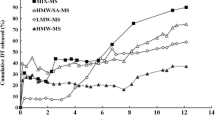Abstract
Poly(lactide-co-glycolide) microspheres containing different loads of OVA (0.05, 0.1, 0.5 and 1.0% w/w) were manufactured by a w/o/w emulsion/solvent evaporation method. Low load efficiencies of less than 20% were observed. Normal size distributions with mean volume diameters ranging from 3.7 to 4.7 µm were obtained for different batches. The in vitro release of OVA from different loaded microspheres showed an expected burst release with all batches. The in vivo dose study (1, 10, 25, 50 µg of OVA) was performed by subcutaneous and oral inoculation in mice by single (0 week) or double (0 and 3 weeks) administration of PLGA 50/50 microspheres containing 0.1% OVA. Subcutaneous administration showed an immune response (serum Ig levels by ELISA) statistically (Fisher’s paired t-test; P < 0.05) above OVA saline negative controls at 3, 6 and 12 weeks after administration. Oral administration of microspheres produced statistically higher systemic immune responses at the higher doses. Single and double inoculation orally and subcutaneously produced similar serum antibody levels. The in vivo load study was performed by subcutaneous and oral administration to mice of 25 µg OVA contained in various loaded (0.05, 0.1, 0.5 and 1.0% w/w) microspheres. Serum immune responses at 3, 6, and 12 weeks after inoculation were statistically above OVA saline controls and were inversely proportional to the OVA load using either route. This observation suggested a relationship between the number of microspheres delivered and the in vivo serum response. Single subcutaneous administration of 0.05 or 0.1% OVA loaded PLGA 50/50 microspheres induced larger immune responses compared with complete Freund’s adjuvant.
Similar content being viewed by others
REFERENCES
Freund, J., The Effect of paraffin oil and mycobacteria on antibody formation and sensitization. Am. J. Clin. Pathol. 21:645–656 (1951).
Beebe, G. W., Simon, A. H. and Vivona, S. Long-term mortality follow-up of army recruits who received adjuvant influenza virus vaccine in 1951–1953. Am. J. Epidemiol. 95:337–344 (1972).
Artursson, P., Martensson, I-L. and Sjoholm, I. Biodegradable Microspheres III: Some immunological properties of polyacryl starch microspheres. J. Pharm. Sci. 75:697–701 (1986).
O'Hagan, D. T., Palin, K., Davis, S. S., Artursson, P. and Sjoholm, I. Microparticles as potentially orally active immunological adjuvants. Vaccine. 7:421–424 (1989).
Kreuter, J., Berg, U., Liehl, E., Soliva, M., and Speiser, P. P. Influence of the particle size on the adjuvant effect of particulate polymeric adjuvants. Vaccine. 4:125–129 (1986).
Eldridge, J. H., Hammond, C. J., Meulbroek, J. A., Staas, J. K., Gilley, R. M. and Tice, T. R. Controlled vaccine release in the gut-associated lymphoid tissues 1. Orally administered biodegradable microspheres target in the peyer's patches. J. Controlled Release. 11:205–214 (1990).
Vert, M., Cristel, P. and Chabot, F. Bioerodible plastic materials for bone surgery in Macromolecular Biomaterials. CRC press, Boco Raton 120–142, (1984).
Strobel, J. D., Laughin, T. J., Ostroy, F., Lilly, M. D., Perkins, B. H. and Dunn, R. L. Controlled-release systems for anticancer agents. Proc. Int. Symp. Control. Rel. Bioact. Mater. 14:261–262, (1987).
Okada, H., Heya, T., Ogawa, Y., Toguchi, H., and Shimamoto, T. Sustained pharmacological activities in rats following single and repeated administration of once-a-month injectable microspheres of leuprolide acetate. Pharm. Res. 8:584–587 (1991).
Heya, T., Okada, H., Tanigawara, Y., Ogawa, Y., and Toguchi, H. Effects of counteranion of TRH and loading amount on control of TRH release from copoly(dl-lactic/glycolic acid) microspheres prepared by an in-water drying method. Int. J. Pharm. 69:69–75 (1991).
Smith, P. K., Krohn, R. I., Hermanson, G. T., Mallia, A. K., Gartner, F. H., Provenzano, M. D., Fujimoto, E. K., Goeke, N. M., Olson, B. J., and Klenk, D. C. Measurement of protein using bicinchoninic Acid. Anal. Biochem. 150:76–85 (1985).
Uchida T., Yasutake T., and Goto, S. Utility of mixture of commercially available polymers as constituents of sustained-release microcapsules containing cefadroxil or theophylline Chem. Pharm. Bull. 40:463–466 (1992).
Ogawa Y., Yamamoto, M., Takada, S., Okada, H., and Shimamoto, T. Controlled-release of leuprolide acetate from polylactic acid or copoly(lactic/glycolic) acid microcapsules: influence of molecular weight and copolymer ratio of polymer. Ibid. 36:1095–1103 (1988).
Yamakawa, I., Tsushima, T., Machida, R., and Watanabe, S. Preparation of eurotensin analogue-containing poly(dl-lactic acid) microspheres formed by oil-in-water solvent evaporation. J. Pharm. Sci. 81:899–903 (1992).
Benita, S., Benoit, J. P., Puisieux, F., and Thies, C. Characterization of drug loaded by poly(dl-lactide)microspheres. Ibid. 73:1721–1724 (1984).
Cohen, S., Yoshioka, T., Lucarelli, M., Hwang, L. H., and Langer, R. Controlled delivery systems for proteins based on poly(lactic/glycolic acid) microspheres. Pharm. Res. 8:713–720 (1991).
Edman, P., Bjork, E. and Ryden, L. Microspheres as a nasal delivery system for peptide drugs. J. Controlled Release. 21:165–172 (1993).
Tabata, Y. and Ikada, Y. Activation of macrophage in vitro to acquire antitumor activity by a muramyl dipeptide derivative encapsulated in microspheres composed of lactide copolymer. Ibid. 6:189–204 (1987).
Eldridge, J. H., Staas, J. K., Meulbroek, J. A., Tice, T. R., and Gilley, R. M. Biodegradeable and biocompatible poly(dl-Lactide-co-glycolide) microspheres as an adjuvant for Staphylococcal Enterotoxin B toxoid which enhances the level of toxin-neutralizing antibodies. Infect. Immune. 59:2978–2986 (1991).
Ebel, J. D., A method for quantifying particle absorption from the mouse small intestine. Pharm. Res. 7:848–851 (1990).
Lefevre, M. E., Boccio, A. M. and Joel, D. D. Intestinal uptake of fluorescent microspheres in young and aged mice. Proc Soc Exp Biol Med 190:23–27 (1989).
Tabata, Y. and Ikada, Y. Phagocytosis of polymeric microspheres. High Perf. Biomat. 621–46 (1991).
Jani, P. G., Halbert, W., Langridge, J. and Florence, A. T. The uptake and translocation of latex nanospheres and microspheres after oral administration to rats. J. Pharm. Pharmacol. 41:809–812 (1989).
Author information
Authors and Affiliations
Rights and permissions
About this article
Cite this article
Uchida, T., Martin, S., Foster, T.P. et al. Dose and Load Studies for Subcutaneous and Oral Delivery of Poly(lactide-co-glycolide) Microspheres Containing Ovalbumin. Pharm Res 11, 1009–1015 (1994). https://doi.org/10.1023/A:1018987404751
Issue Date:
DOI: https://doi.org/10.1023/A:1018987404751




